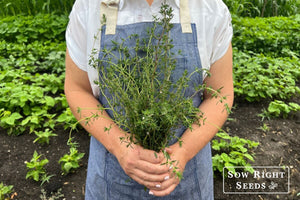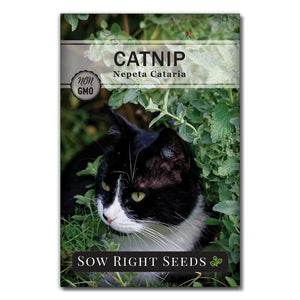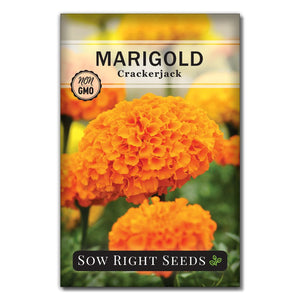10 Best Methods for Controlling Flea Beetles in Your Vegetable Garden
PestsWe recently had an outbreak of flea beetles on our eggplant seedlings. We were wary about flea beetle damage after a horrible infestation of aphids on our indoor seedlings. But with some helpful tips and knowledge of their lifecycle, we were ready to get rid of flea beetles and protect our eggplants and other crops. As we battle common garden pests, we like sharing what we learn with our gardening friends.

Identifying Flea Beetles
It’s not always easy to figure out what pest is munching away on your plants. Some, like thrips, are too small to see; others, like flea beetles, hop away.
Flea beetles are some of the earliest pests in the spring. They emerge from the soil when their favorite crops are starting to grow.
Although not technically fleas like the kind that bite your dogs and cats, flea beetles have the same sort of hind legs that make them excellent jumpers. When you move through your plants, they will jump away just like regular fleas.
If you notice irregular holes and divots in the leaves of your vegetables, you most likely have flea beetles. Disturb the leaves, and you will see black spots jumping around.
Adult flea beetles are small, ranging from 1/16 to 1/8 of an inch. They are dark colored with a shiny hard shell and can be brown or black with stripes or spots.
Flea Beetle Lifecycle
Eggs - 0.4mm elliptical shaped. Flea beetle eggs are usually laid just under the top of the soil. Some species will lay eggs on leaves. Larvae will emerge in about a week.
Larvae - Tiny worms with a white body. They will feed for two or three weeks on very fine root hairs. They can ruin plants with tubers, such as sweet potatoes. Generally, flea beetle larvae don’t harm other plants too much.
Pupa - Larvae pupate in the soil and mature into adults in two to three weeks.
Adults - Once they emerge, adults find their favorite plants and start eating. After a few weeks, the females lay eggs, and the process starts all over again. There are usually two generations in a growing season.
The adult flea beetles are the most harmful to your plants. Adults feast on the plant leaves, leaving various large and small holes and divots in thicker leaves. When plants are in their young seedling stage, they are the most vulnerable. Adult flea beetles prefer these young, tender leaves.
The signs you’ll see from flea beetles are a scattering of irregular holes. These are often called shotgun holes. On thick leaves, the beetles won’t make holes all the way through. These divots and unique holes will help you identify which pest is attacking your plant.
The most critical time to control flea beetles is in the spring when you have young plants and high numbers of beetles. In the summer, the number of beetles declines, and the plants are big enough to be less affected by the leaf damage.

Flea Beetles on Eggplants
Some varieties of flea beetles focus on plants in the Solanaceae family, including eggplants, potatoes, tomatoes, and peppers.
We first noticed flea beetles on our eggplant seedlings this year. There were signs of them on the kale, but they didn’t do as much damage there. Each species of flea beetles will have a host crop, but some will feed on just about everything.
The good news is that once the eggplants are large enough, flea beetles usually don’t do enough damage to destroy them. Adult flea beetles fly off to other areas when the host plant is unavailable.
Flea beetles on cabbage
There are flea beetle species that target cruciferous vegetables such as cabbage, kale, radishes, and turnips. These plants can benefit from floating row covers since they don’t rely on pollinators. Just make sure you don’t already have flea beetles coming up from the soil underneath the row covers.

Controlling Flea Beetles
Although there are many species of flea beetles, the options for control will pertain to most of them.
1 - Row Covers
Use row covers when plants are young. These barriers can keep flea beetles from coming in from other areas. Remove the covers when the plants start flowering so they can be pollinated. Row covers should be made of a light fabric that allows airflow and light.
2 - Plant Trap Crops
Trap crops can used to attract flea beetles. These crops are sacrificed for the benefit of the other plants. Radishes are an excellent trap crop. Plant trap crops before your main crop. Once the beetles are feasting on the radish tops, you can apply a pesticide. Or, better yet, use nets or a hand vacuum to gather them up.
3 - Grow Plants that Repel Beetles
Plants that repel beetles have a strong scent, such as thyme, basil, catnip, and other mints. These can hide the smell of other plants. Bunching onions have also been used in test gardens to repel flea beetles. If you go this route, plant these flea beetle-repellent crops next to the plants you want to “hide” from the beetles. Plant any trap crops further away to lure beetles away from your eggplants and other crops you wish to protect.
4 - Attract Natural Predators
Some insects will feed on flea beetles. These natural flea beetle predators include lacewings, braconid wasps, and tachinid flies. Planting flowers and plants that attract these predators will encourage them to live in your garden. Plants for flea beetle predators are those that have umbrella-type flowers, such as fennel, coriander, marigold, and yarrow.
5 - Beneficial nematodes
Nematodes work in the soil and can help eliminate flea beetle pupates. Follow the package directions for adding nematodes to the soil.
6 - Diatomaceous Earth
Diatomaceous earth repels most types of flea beetles. It is made from the skeletal remains of sea creatures called diatoms. Dusting plants with diatomaceous earth doesn’t hurt the plants but makes the leaves no fun for flea beetles to munch on.
7 - Kaolin clay
Kaolin clay is a mineral used in making ceramics. This crystal-like dust can be mixed with water and sprayed onto leaves. Both DE and kaolin clay dusts can wash off and need to be reapplied after it rains.
8 - Garden Hygiene
Keeping a clean garden can help break the lifecycle of flea beetles. Clean up debris in your garden before winter to reduce the places where flea beetles hide. Control weeds during the growing season, especially those that may attract more flea beetles.
9 - Planting Schedule
You can avoid the worst time for flea beetles by waiting to plant until later in the season. Or you can start seeds indoors and wait longer to transplant.
10 - Pesticides
Insecticides can be used, but flea beetles are highly mobile, and pesticides can hurt beneficial pollinators. Only use these types of sprays if infestations are more than just a nuisance. Both spinosad and pyrethrin sprays are effective in controlling flea beetles.
Yellow sticky traps can identify beetles but aren’t practical for control. Also, they will trap other beneficial pollinators. Crop rotation can be helpful. Flea beetles have specific plants they eat, so rotating crops can help by reducing their host crop. Neem oil is another spray that is sometimes used to control flea beetle populations.
Now, you’re equipped with ways to control flea beetles when they attack your garden. As always, having a mix of crops and staggering planting times can help you not be overwhelmed by any one pest in your garden. Flea beetles aren’t fun to see, but you can take measures to rid them from your favorite vegetables.
Written by Beverly Laudie








Leave a comment